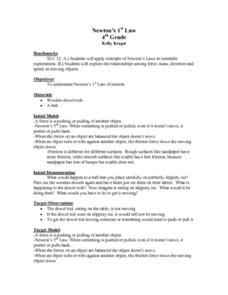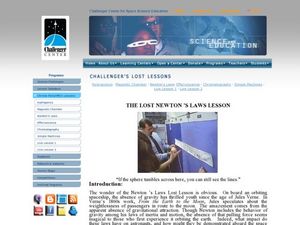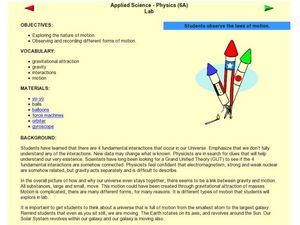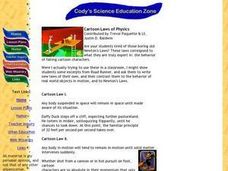Physics Classroom
Recognizing Forces
A common complaint among physics scholars studying Newton's laws of motion concerns drawing free-body diagrams. To practice the required pre-requisite skills for free-body diagrams, individuals identify which forces act in specific...
Physics Classroom
Fnet = m•a
Most pupils learn quickly how to apply Newton's Second Law equation to calculate net force. However, many struggle to determine net force before calculating the value of an unknown force from a force diagram. As part of a larger series...
Physics Classroom
Match That Free-Body Diagram
Pupils read a description of a physical situation and select the free-body diagram that best matches. As part of a series on applying Newton's Laws of Motion, scholars reinforce their skills applying forces and considering their relative...
Curated OER
Pop Rocket - Trash to Treasure
First off, Newton's laws of motion aren't often taught at 2nd grade, so this lesson may be more appropriate for upper elementary learners. It begins with a discussion and demonstration of the laws of motion, and then has individuals...
Curated OER
A Quiz About Newton's Laws
In this Newton's laws worksheet, learners review the definitions of the law of inertia, law of acceleration, and the law that relates force to acceleration. This worksheet has 10 short answer questions.
Curated OER
Newton's Ist Law
Fourth graders explore Newton's First Law of Motion. They conduct an experiment to observe what happens to a ball that is placed carefully on slippery ice. They also observe what happens to a dowel on the ice, then draw and label...
Curated OER
Forces
In this forces worksheet, students read about Newton's law of motion and decide whether pictures are pushing or pulling. Students decide the push or pull for 4 pictures.
Curated OER
The Lost Newton's Laws Lesson
Students explore momentum. In this physics lesson, students perform an experiment in which two balls are released on slanted boards while students observe which ball will go the farthest and the fastest. Students define and explain...
Curated OER
Newton's 2nd Law
Fourth graders explore Newton's second law of motion, testing and identifying the characteristics of objects that makes them easier or harder to push. They identify what types of objects are the hardest to move, then test a variety of...
Curated OER
Motion Experiment
Students experiment with the laws of motion. In this motion lesson, students explore Newton's Laws of Motion. Students work in groups experimenting with different objects and observing different types of motion.
Curated OER
Forces and Newton's Three Laws
Students watch demonstrations of forces and Newton's Three Laws. In this forces lesson, students watch four demonstrations and complete the associated worksheets associated with Newton's Laws. There is a PowerPoint that can be accessed...
Curated OER
Isaac Newton's Third Law of Motion
Ninth graders experiment with Isaac Newton's Third Law of Motion. In this Third Law of Motion lesson, 9th graders develop an experiment that shows their understanding of this theorem. They work in small groups to read an article at a...
Curated OER
Newton Rocket Car
Young scholars observe a demonstration of Newton's third law of motion using a small wooden car. They discuss Newton's third law of motion and what happens to motion if the mass or acceleration is increased, construct their car, and...
Curated OER
Cartoon Laws of Physics
High schoolers are introduced to Newton's Laws. They are shown excerpts from Road Runner, and students are asked to write new laws of their own, and then constrast them to the behavior of real world objects in motion, and to Newton's...
Curated OER
Describing Motion
In this motion worksheet, students will use Newton's third law of motion to compare the force of objects on Earth with objects on Jupiter. This worksheet has 5 short answer questions.
Curated OER
Newton's Hat Trick
Students are challenged to develop skits illustrating each of Newton's three laws of motion. They are asked to identify examples of Newton's laws in sports. Students are asked how does Newton's third law allow a runner to run?
Institute of Electrical and Electronics Engineers
Water Rocket Launch
How do rockets fly? Teams design, build, and launch a rocket made from a two-liter bottle to explore forces on a rocket such as Newton's Laws of Motion. During the design phase, young engineers draw a diagram of their rocket and include...
Urbana School District
Forces
Is your class struggling with Newton's Second Law? Then show them a presentation that covers everything physics scholars need to know about forces. Starting with gravity, the slides focus on Newton's Laws of Motion, and end with an...
DiscoverE
Slinky® Science
Toys are great for learning about physics. Scholars use Slinky® toys to study Newton's laws of motion and types of energy. After a little play, they then model longitudinal and transverse waves with the Slinky® toys.
Workforce Solutions
Newton's Laws
Two lessons explore the connection between energy transformation and a given job. In instructional activity one, small groups role-play a scenario that showcases the energy transformations that may take place during a job-specific task....
Olathe Public Schools
Forces, Net Forces & Acceleration
Pass along the knowledge of the great Sir Isaac Newton with this worksheet on the laws of motion. Including three separate problems, each involving multiple parts and calculations, this resource is a great way to monitor students'...
Curated OER
Playing With Science
Young scientists investigate the scientific concepts and principles that help make common toys such as hula hoops, yo-yos, slinkies, and silly putty work. As a class, they read "Backyard Rocket Science, Served Wet" to get a look behind...
Curated OER
Projectile Motion
Students observe projectile motion and calculate the speed of a baseball based on the time and distance traveled. They record the time, measure the distance, and draw the path of the ball's travel on a data table.
Curated OER
Newton's Challenge
In this Newton's challenge worksheet, middle schoolers demonstrate their understanding of Newton's laws by performing several mini labs. Students answer questions that ask to describe the movement of each demonstration using Newton's laws.

























